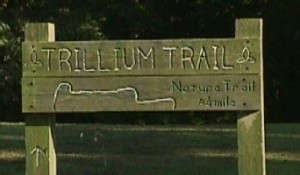Horner Park Trillium Trail
Trillium Trail is a one quarter mile long nature trail at Horner Park. It was constructed in 1994 by Neva Laurie as part of her Girl Scout Gold Award project. The material below is based on a pamphlet that Ms Laurie prepared as part of her project.
She gives a brief history of the park, a guide to flowering plants and a guide to animal tracks.
[webmaster’s note: The tracks section is under repair and is not available at this time.]
A Brief Guide to Trillium Trail
Introduction
Trillium Trail was my project for my Girl Scout Gold Award, the highest award in Girl Scouts. The project is the final and hardest part of the Gold Award. It requires a four month effort. The scout is not required to do all the work, but she must organize and direct it.
I’d like to thank my father Lynn, brother Alex, David Christ, Larry Taylor, Adam Shake, and Harrison Church. A big thanks to Kuhn Lumber for the donation of materials for the bench and signposts. I also wish to acknowledge the park board for their support. A special thanks goes to the two people who helped me the most, my mother and troop leader Connie Laurie, and Jerry Smith, park caretaker. This nature trail wouldn’t have been possible without them. My deepest gratitude to them both.
Sincerely,
Neva Laurie
Senior Girl Scout
Park History
This land became a park in 1947 when Hattie Hypes Horner died and left the estate as a memorial of what her family did for Lebanon. Her father was the first mayor in 1847, and the family has a lengthy history in the area before and after then.
The spring house at the head of the trail was built to harness the water coming from the “sulphur spring,” probably for commercial uses. The spring and creek, however, had been used for decades before that by Indians, wildlife, and early settlers to the area. As recently as a few years ago, the water from the spring was still being used by families, mine included, as a fun, cold drink on hot summer days. But the water now has been declared unsafe for drinking, so that practice has been discontinued.
The creek is still being used as a water source by numerous animals (They don’t care if it’s pure or not.), and people enjoy the coolness it gives to this low area.
Flowering Plants on Trillium Trail
While you’re walking this trail, keep an eye for some of the following wildflowers.

White Trillium (Trilliumgrandiflorum)
There are two types native to this area, white trilliums and wake robins.
Like all trilliums, they have three leaves to a single stalk, and the flowers are formed of three pointy petals.
White Trillium – Its ruffly, pointed leaves are a dark green with heavy veining, and the flowers are white. It can grow to two feet in height. The white flower opens fully, unlike the Wake Robin which remains curled.
Wake Robin Trillium (T. Erectum)
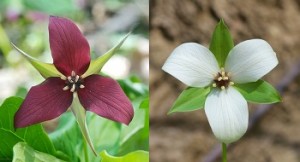
Wake Robin is much smaller than its showy relative, this early spring flower
gets its name because it blooms about the time the robin returns. The leaves are variegated, green
and a brownish grey. The flower is a deep reddish brown.
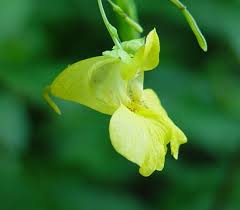
Jewelweed
(Impatiens pallida)
This plant has bright orange flowers in late summer. The seeds that form in the fall go flying if the plant is brushed against, earning it the name of Touch-me-not. Rubbing its leaves and stems on poison ivy rashes can be soothing.
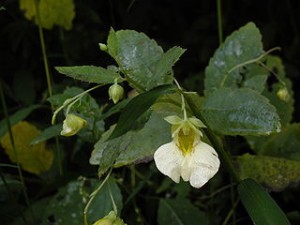
False Solomon’s Seal (Smilacina racemosa)
Like Solomon’s Seal, the leaves grow alternating on a stalk. The difference in the two is the placement of the flowers. Solomon’s Seal plants hang their flowers down along the stem, but this plant has its white flowers in clusters at the end of the stalk.
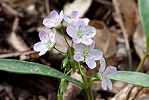
Spring Beauties (Claytonia virginica)
These small plants have leaves resembling blades of grass. Their little white flowers often have deep pink veins running through their petals. One of the first of the spring flowers.

Wooly Blue Violet (Viola cucullata)
The most common violets for this area, the Wooly Blue (also known as the Marsh Blue) Violet grows in clumps, each stem bearing a heart shaped leaf or a dark purple flower.
State flower of Illinois.
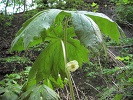
Mayapple (Podophyllum peltatum)
This umbrella shaped plant tends to come in clusters resembling small forests. The plants with branched stalks form small white flowers in May, and the fruit, resembling apples, develops later in the summer.
Unless picked when perfectly ripe, these “apples” are poisonous.
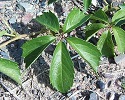
Virginia Creeper
(Parthenocissus quinquefolia)
Though it resembles poison ivy, Virginia Creeper (also known as Woodbine) is perfectly harmless. You can tell the two apart by Virginia’s star-shaped clusters of five leaves. It makes small, green-white flowers and blue berries, but these are small and you’ll
have to look close to see them. The leaves turn a beautiful scarlet in the fall.
Things to watch out for on the trail
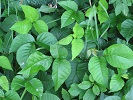
Poison Ivy (Rhus toxicodendron)
As we discovered while working on this trail, this area is thick with
poison ivy, a glossy three-leaved plant. We cleared it from the trail itself, but it’s still growing
along the sides of the trail. The oil from its leaves causes itching rashes when it comes in contact
with skin. If you stay on the trail and watch what plants you brush against, you should be
fine.
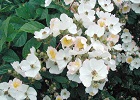 Multiflora Rose, another plant that lines the trail in places can be irritating in other ways. It’s covered with small, sharp thorns. You don’t want to stray from the trail into one of these bushes. Take it from me, the voice of experience.
Multiflora Rose, another plant that lines the trail in places can be irritating in other ways. It’s covered with small, sharp thorns. You don’t want to stray from the trail into one of these bushes. Take it from me, the voice of experience.
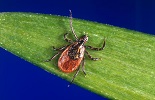
Also, though we didn’t see any while working out here, there are ticks in this area. You
probably won’t get any if we didn’t, but it’s a good idea to be aware of them, just in case.

